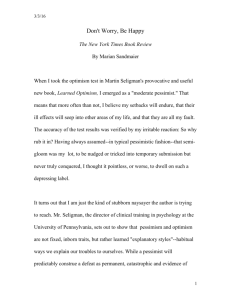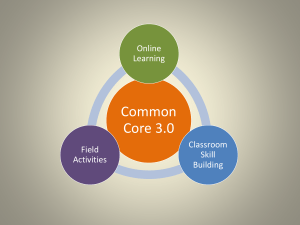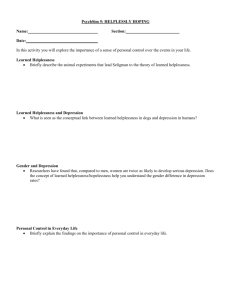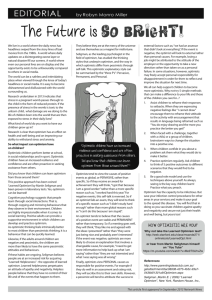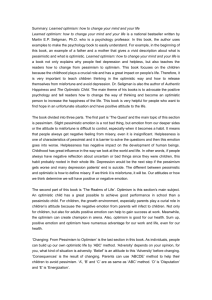Learned ReaLISM
advertisement
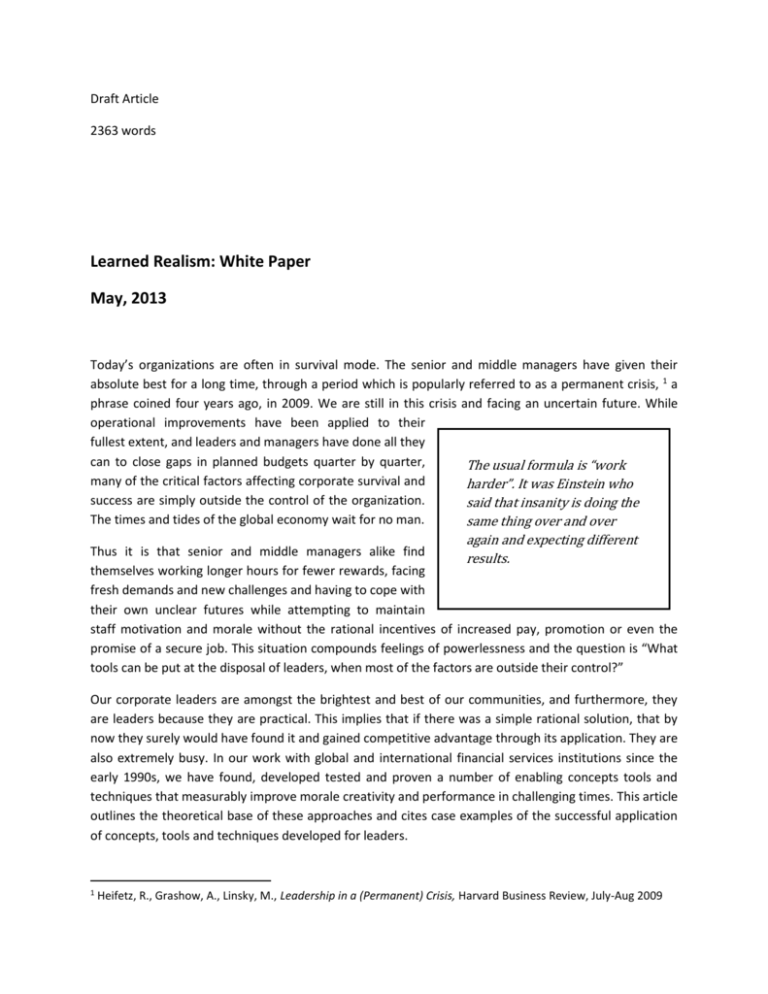
Draft Article 2363 words Learned Realism: White Paper May, 2013 Today’s organizations are often in survival mode. The senior and middle managers have given their absolute best for a long time, through a period which is popularly referred to as a permanent crisis, 1 a phrase coined four years ago, in 2009. We are still in this crisis and facing an uncertain future. While operational improvements have been applied to their fullest extent, and leaders and managers have done all they can to close gaps in planned budgets quarter by quarter, The usual formula is “work many of the critical factors affecting corporate survival and harder”. It was Einstein who success are simply outside the control of the organization. said that insanity is doing the The times and tides of the global economy wait for no man. same thing over and over again and expecting different Thus it is that senior and middle managers alike find results. themselves working longer hours for fewer rewards, facing fresh demands and new challenges and having to cope with their own unclear futures while attempting to maintain staff motivation and morale without the rational incentives of increased pay, promotion or even the promise of a secure job. This situation compounds feelings of powerlessness and the question is “What tools can be put at the disposal of leaders, when most of the factors are outside their control?” Our corporate leaders are amongst the brightest and best of our communities, and furthermore, they are leaders because they are practical. This implies that if there was a simple rational solution, that by now they surely would have found it and gained competitive advantage through its application. They are also extremely busy. In our work with global and international financial services institutions since the early 1990s, we have found, developed tested and proven a number of enabling concepts tools and techniques that measurably improve morale creativity and performance in challenging times. This article outlines the theoretical base of these approaches and cites case examples of the successful application of concepts, tools and techniques developed for leaders. 1 Heifetz, R., Grashow, A., Linsky, M., Leadership in a (Permanent) Crisis, Harvard Business Review, July-Aug 2009 Learned Helplessness Limits Performance In the 1960s, Seligman2 conducted a series of experiments on animals. One group of dogs was fed normally, and another given unavoidable shocks when food was presented. The second group, with others who had not been given shocks, was then required to jump a barrier within 10 seconds of a warning signal or receive another shock. The first group quickly learned the response and jumped the barrier. About 66% of the group who had been given shocks were group were not able to learn the required behavior. They were resigned to being hurt. Some of them needed to be pushed over the barrier 200 times before they learned how to avoid the shocks. Similar hopelessness about the effect of one’s behavior after exposure to unpleasant stimuli was noted by Norman (1979)3 and Seligman (1976) argued that human depression was of a comparable nature. Exposure to continued external and unavoidable shocks creates powerlessness. The implications for leaders today are profound. At this moment and for some time after crisis, we should expect to see resignation, hopelessness and risk aversion to an irrational extreme. And even if the tools for change are made available, it might take “200 pushes” to actually change behaviors to avoid new dangers or to take advantage of new opportunities. Furthermore, the human dynamic of depression alternating with euphoric mania appears to be remarkably similar to the group behaviors of risk aversion and over optimism found through the stages of bust and boom of the business cycle. There also seems to be a lead- lag effect, where for long periods of time after a trough or peak, rational decision making is distorted by recent experiences. This way, over-optimism lengthens the period of unwise investments after the peak of the upswing and human depression lengthens the periods of economic depression at the bottom of the downswing. It is important to note here that the process of either being depressed or being overoptimistic is primarily not essentially rational. It takes control without one’s awareness. It just happens. It is a “below the surface” phenomenon. Nonetheless there are rational means of managing it both personally and as a corporate leader responsible for the performance of an organization. 2 3 Seligman,M., Biological Boundaries of Learning, New York Appleton Century –Crofts, 1972 Norman, M., Substitutes for Mother, Human Behaviour, Feb,1978 Rubin and McNeil 4 showed that that if we experience periods of being in control, then subsequent imposition of rules and felt loss of control can produce a reaction of assertion of freedom, an involuntary non-compliance. Seligman then showed that over a period of time, as felt loss of control continues, the anxiety associated with trauma or loss of control is replaced by depression. This link between loss of control and learned helplessness make sense when we consider that as regulatory bodies have necessarily taken greater control of the financial services industry, managers have had decreasing control over their work. At the same time, because of market conditions they have been unable to achieve planned goals. Brown5 noted that where people perceived that they had little control, then they found events much more stressful and Johnson and Sarason (1978) found that people who felt that events happened to them (i.e., had an external locus of control) were more prone to depression and anxiety than those who felt that their decisions mattered (i.e., who experienced an internal locus of control). “They have turned off the light at the end of the tunnel to save electricity”. Learned Optimism Gets Results But the news is not all bad. Tollman and Honzik (1930)6 conducted an experiment in which a group of rats in a maze were rewarded with food when they found the correct path. Another group were not rewarded and wandered aimlessly. However, after 11 days they were rewarded and it was discovered that they could navigate the maze as quickly as those who had been rewarded every day. The conclusion was that while they had been aimlessly wandering the maze they had been building cognitive maps which were immediately put to use once conditions changed! This was called latent learning. The implication is that during fallow periods of business, there is still activity. Individuals are mapping the territories, building potential for action. There is even better news. In recent years, Seligman discovered the phenomenon of ‘learned optimism”. In the same way that his early experiments showed how helplessness could be learned, his later work demonstrated how optimism could be learned. He developed a diagnostic test looking at the three factors which indicate pessimism. These are: permanence (bad situations are seen as permanent states); pervasiveness (single negative situations are generalized); and personalization (seeing the problem as inside rather than outside). Seligman then developed a training approach based on learned optimism which has been extensively applied throughout US firms and the United States military. 4 Rubin, Z and McNeil, E.B., The Psychology of Being Human. London, Harper Row, 1983 Brown, R., Social Psychology, New York, Free Press 6 Tolman, E.C., & Honzik, C.H., “Insight” in Rats”, University of California Publications in Psychology, 1930 5 The research had an impact on the training of professional sales people7 where optimism is a critical factor of temperament correlated to success. It corresponds with our own experiences of assisting firms to increase revenue in that successful high value sales people generally had high optimism scores on a standard psychological tool customized for the financial services industry8. Learned Realism is Better The concept of learned optimism is based on cognitive behavioural techniques pioneered by Albert Ellis9. A useful caution is provided by Ablow10 who suggests the over-application of learned optimism, to the point of “false bravado” should be guarded against, as the denial of trauma and stress is unhelpful. This critique resonates with the views of depth psychologists such as C.G Jung 11who emphatically argue for a balanced realistic approach which supports the positive while respecting the real difficulties people have encountered. Our experience working with complex global organizations and in particular with the financial services industry, suggests that just such a positive approach, if tempered by realism yields significant returns. Reviewing the literature, and comparing theory with practice, there are two subtle distinctions to be made. Firstly, on the one hand, seeing oneself as the source of problems can be a form of personal improvement by taking responsibility (Saarson, 1978) and can be empowering. This is not to be confused with Seligman’s idea of resilience, where one does not see oneself as the main cause of negative experiences and can isolate negative events. There is room for growth in both in both directions, and this can be determined by separating controllable and intrinsic factors from uncontrollable extrinsic factors and planning from there. Post 2000 studies on motivation built on the seminal work conducted by Connell and Wellborn12 showed that for professionals, the intrinsic motivators of competence (the sense of doing a good job) relatedness (a sense of community at work) and autonomy (control over their own work) were highly significant. In the absence of the extrinsic motivators of pay and promotion, leaders might incorporate these “people motivation” factors into management practice. When conditions of stress prevail, not enough time is given to learning how to deal with it and to find new ways of being creative. The usual formula is “work harder”. It was Einstein who said that insanity is doing the same thing over and over again and expecting different results. Ryan et al (2009)13 discovered that the performance and well-being of schoolchildren was greatly improved by slowing them down and helping them to work through deeper problem analysis and the generation of multiple alternative 7 Schulman, P., Applying learned optimism to increase Sales Productivity” Journal of Personal Selling and Sales Management, Winter, 1999 8 Asses on-line questionnaire, report and training recommendations used for several thousand sales professionals. 9 Ellis , A., How to make yourself happy and remarkably less disturbed. Impact Publishers Inc, 1999 10 Ablow, K.,Bad Psychiatric Policy and the Afghan Massacre The Mind of the News, Fox News March 2012 11 Jung, C.G., Psychological Types, Collected Works, Vol 6, Princeton University Press, 1971 12 Connell, J.P., Wellborn J.G., Aelf processes and development. The Minnesota symposia on child psychology, Vol.23., (pp43-77). Hillsdale, 1991:Lawrence Erlbaum Associates Inc. (1991) 13 Ryan R.M. et al Self determination and physical activity. The dynamics of motivation development and wellness. Hellenic Journal of Psychology, 6, 2009 solutions. Most business process improvement initiatives pay careful attention to this apparently simple activity. It is simply not done habitually under conditions of stress. Combining this approach with soft skills training grounds enablement in business realism. So far, we have established that the permanent crisis produces learned helplessness, and depression. This has a serious effect on business morale and in turn on commercial performance in that it creates risk aversion to an unreasonable extreme, inhibits learning, problem solving and creativity and fuels a downward spiral. Key features are apathy, upward delegation, lack of acceptance of responsibility, blaming others (based on external locus of control) and resistance to positive initiatives. The feeling was neatly expressed in the quote of a senior executive of a major corporate client who said “They have turned off the light at the end of the tunnel to save electricity”. Given this picture, it follows that where learned helplessness can be unlearned, then morale will improve, appropriate risks will be taken, personal responsibility will return and the learning, problem solving and creativity necessary for building a way forward will be released. If this can be achieved more quickly than the competition, advantage can be gained. What are required are both “learned realism” and a sense of optimism which will bring about the imagined conditions. This fuels “adaptive leadership”14. The interactive nature between our private imaginings and life events has become a subject of great business interest. It was perhaps first mooted by C G Jung who with reference to developments in physics noted the mirroring of the ‘below the surface world’ of our deepest imaginings and the realities of life. We build what we dream. There are Proven Practical Solutions There are a number of proven concepts, tools and techniques which have been developed from research and practice at the disposal of leaders. These can help to turn a spiral of corporate depression into an upward spiral of creativity and positive action, even give today’s tough conditions. The first and most important of these tools is self development, working on one’s own mindset with an experienced coach. People are unique. Fastest results are achieved when we share enough of our personal and professional visions and doubts, hopes and concerns with a leadership development professional who understands business and people dynamics well enough to be able to listen, understand and help to develop internal locus of control. The second is team development addressing problem solving, learning and creativity. 14 Heifetz, R., Grashow, A., Linsky., M., Leadership in a (Permanent) Crisis Harvard Business Review, 2009 In a case study of a retail bank in the UK during the last recession, during the course of a transformation program affecting 60,000 people, we applied these principles in combination to the lowest performing sales Region, which as a result of training progressed from bottom to joint first (of 8 regions) in a period of 18 months. Similarly in a German global bank we used the same techniques to drive and support a 2 year performance improvement program resulting in dramatically improved return on capital employed and improved cost income ratio and our work with a global pharmaceutical company is on record in the European Business Journal15. Our work in the nuclear power generation industry, and notably the turnaround of one of the leading suppliers was based on the application of these tools and techniques. Unique teams require unique methods, and building on our proven methods of energizing teams we have more recently found some short-cut methods which stimulate and accelerate learning, creativity and productivity in groups in the current economic conditions. These have been developed in cooperation with international banking, law and consulting companies and we will publish our research in 2014. John O’Brien May, 2013 John O’Brien has provided leadership consulting services to the world’s leading corporations for more than twenty years. He has assisted many of the global financial services institutions in Europe and the USA to achieve superior results through all stages of the business cycle. He has also led significant “people change” projects in the pharmaceutical industry and contributed to the turnaround of the nuclear power industry in Great Britain. 15 O’Brien J., & Weder., B., Stimulating Productivity in Complex Global Organisations European Business Journal, 2003
